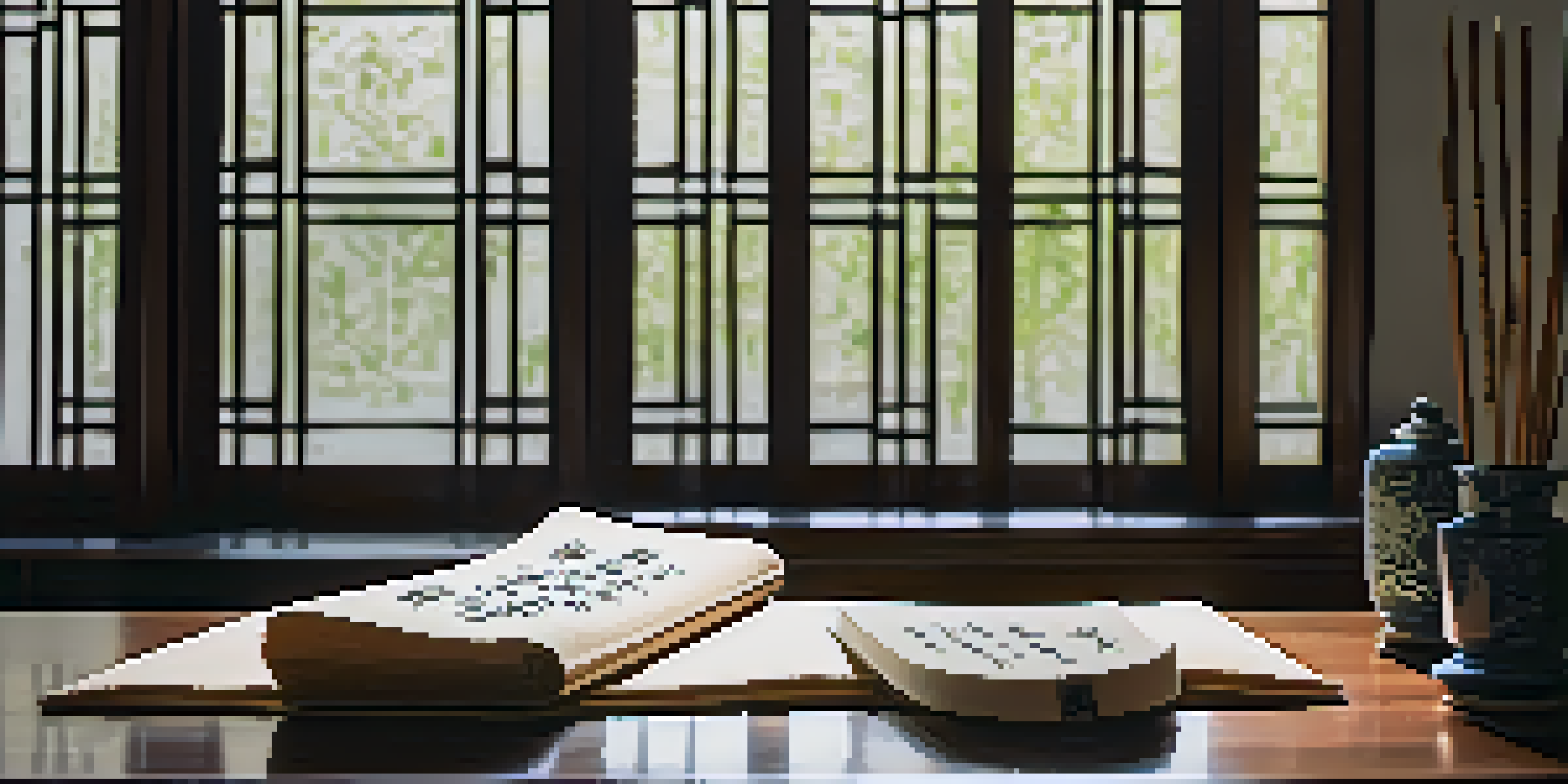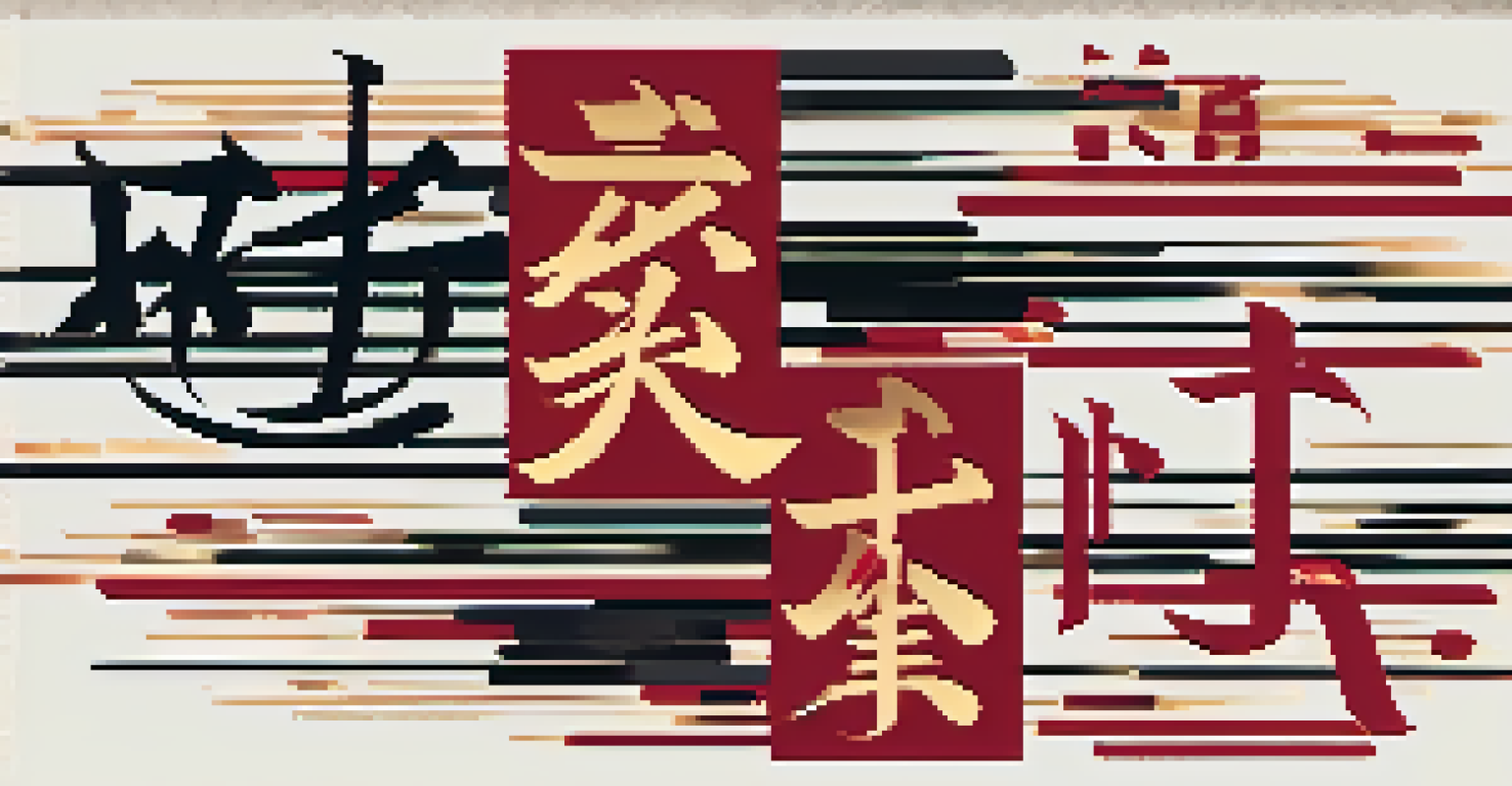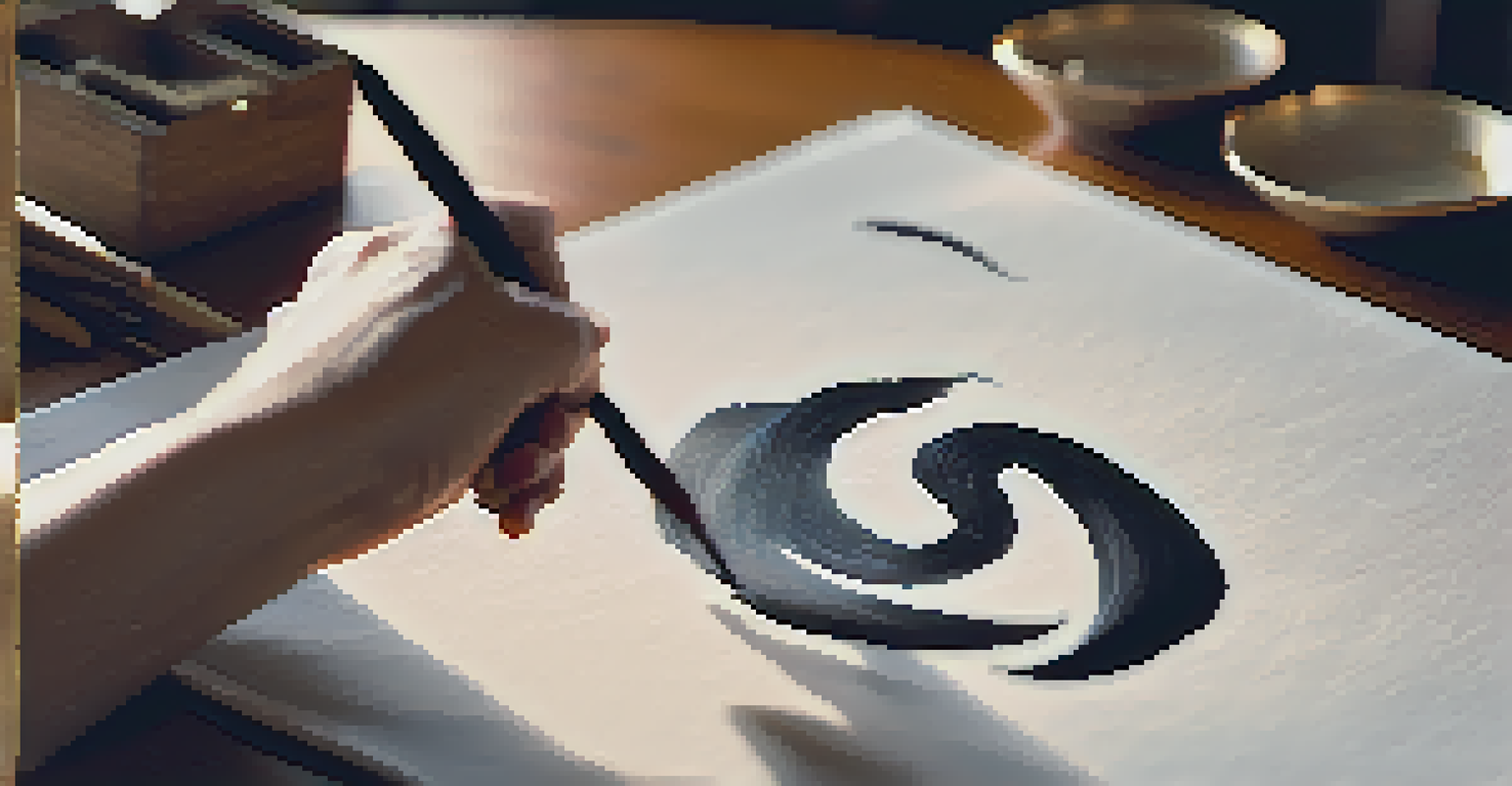Chinese Calligraphy and Its Influence on Western Typography

The Art of Chinese Calligraphy: A Brief Overview
Chinese calligraphy is more than just writing; it's an art form that emphasizes the beauty of brush strokes and the flow of ink. Each character is a unique representation of the artist's emotions, techniques, and cultural significance. Calligraphers spend years honing their skills, learning to balance precision with creativity, which makes every piece a captivating expression of individuality.
The brush is an extension of the artist's hand; it is a bridge between the mind and the heart, and through it, the soul speaks.
Traditionally, Chinese calligraphy is steeped in history and philosophy, often linked to Confucianism, Taoism, and Buddhism. This rich cultural backdrop adds depth to the strokes and characters, transforming simple letters into a visual language that speaks to the soul. The practice itself is seen as a meditation, allowing artists to connect with their inner selves while creating.
As the world becomes more interconnected, the influence of Chinese calligraphy is gaining recognition beyond its borders. Artists and designers are increasingly inspired by its aesthetic appeal, which encourages a fusion of styles that enriches both Eastern and Western art forms.
Key Elements of Chinese Calligraphy That Inspire Typography
Several key elements define Chinese calligraphy, such as the varying thickness of strokes, the use of negative space, and the fluidity of motion. These characteristics contribute to the overall rhythm and harmony of the written piece, making it visually striking. When these elements are translated into typography, they create fonts that evoke emotion and personality.

For instance, the brush-like quality of certain typefaces mimics the expressive strokes found in calligraphy, capturing a sense of movement and vitality. Designers often borrow the idea of balance from calligraphy to create type that is not only legible but also visually engaging. This interplay of form and function is essential in modern design.
Chinese Calligraphy as Art
Chinese calligraphy transcends writing, serving as a profound artistic expression that reflects emotions and cultural depth.
Additionally, the emphasis on asymmetry in Chinese calligraphy introduces a fresh perspective to Western typography, which traditionally favors symmetry. This departure from convention can lead to innovative designs that challenge the status quo, inviting viewers to appreciate the art of lettering in new and exciting ways.
Comparing Chinese Calligraphy and Western Typography
While Chinese calligraphy focuses on individual characters, Western typography often emphasizes the arrangement of multiple letters to form words. This fundamental difference highlights how each culture approaches the written word. Chinese characters are ideograms, meaning they convey ideas rather than sounds, whereas Western letters are phonetic, representing sounds that form words.
Typography is the craft of endowing human language with a durable visual form.
Despite these differences, both art forms share a common goal: to communicate effectively and beautifully. The nuances in stroke techniques in calligraphy can inspire typographers to explore new textures and styles, creating fonts that are both aesthetically pleasing and functional. This cross-cultural exchange enriches the design landscape, fostering creativity.
Moreover, the storytelling aspect of both calligraphy and typography can be quite similar. Each character or letter carries meaning and emotion, whether it's a single Chinese character or a carefully crafted Western typeface. This narrative quality enhances the viewer's experience, making the written word resonate on a deeper level.
Influential Designers Merging Calligraphy with Typography
Several contemporary designers are at the forefront of merging Chinese calligraphy with Western typography, creating innovative works that pay homage to both traditions. Designers like Yu Cheng, who specializes in type design influenced by Chinese aesthetics, exemplify this fusion. Their work showcases how traditional elements can be adapted to modern contexts, breathing new life into typography.
Another notable figure is Li Wei, who incorporates calligraphic styles into digital typefaces, demonstrating that the beauty of brushwork can be preserved in a digital format. By experimenting with texture and form, these designers push the boundaries of what typography can be, inviting audiences to appreciate the artistry behind letters.
Fusing Calligraphy with Typography
The integration of Chinese calligraphy into Western typography inspires innovative designs that balance aesthetics and functionality.
Through workshops and collaborations, these designers are also educating others about the importance of cultural exchange in design. By sharing their techniques and insights, they inspire a new generation of typographers to explore the rich heritage of both Chinese calligraphy and Western typography, ensuring that this dialogue continues.
The Role of Technology in Modern Calligraphy and Typography
Technology has revolutionized the way we create and interact with typography, including the influence of calligraphy. Digital tools allow artists to experiment with brush strokes and styles that were once limited to traditional media. This accessibility opens up new possibilities for blending techniques from Chinese calligraphy with contemporary design practices.
For instance, software like Adobe Illustrator and Procreate enables designers to emulate the fluidity of brushwork, making it easier to create typefaces that reflect the grace of calligraphy. As a result, we see a growing trend of typography that combines hand-drawn elements with digital precision, capturing the essence of both worlds.
Moreover, the rise of online platforms allows for the sharing and appreciation of this fusion on a global scale. Social media has become a canvas for artists to showcase their work, garnering inspiration and feedback from a diverse audience. This interconnectedness fosters a vibrant community where creativity knows no borders.
Cultural Significance of Merging Calligraphy and Typography
The blending of Chinese calligraphy with Western typography goes beyond aesthetics; it carries cultural significance as well. This fusion symbolizes the growing appreciation for diverse artistic traditions and the importance of cross-cultural dialogue. As designers explore these influences, they contribute to a richer narrative that reflects the interconnectedness of our global society.
Moreover, this artistic exchange encourages a greater understanding of cultural heritage and history. By incorporating elements from different traditions, designers can tell stories that resonate with a wider audience, fostering empathy and appreciation for various art forms. Each piece becomes a conversation starter, inviting viewers to explore the nuances of both cultures.
Cultural Significance in Design
Merging calligraphy and typography enriches cultural dialogue and appreciation, fostering a global understanding of artistic traditions.
Ultimately, the merging of these two artistic disciplines serves as a reminder that creativity knows no boundaries. It highlights the beauty that can emerge when different perspectives come together, enriching our visual landscape and encouraging collaboration in the design community.
The Future of Typography Influenced by Chinese Calligraphy
As we look ahead, the influence of Chinese calligraphy on Western typography is likely to continue evolving. Designers are increasingly recognizing the value of incorporating diverse cultural elements into their work, which can lead to groundbreaking designs that challenge conventions. This trend promises to keep the dialogue between East and West alive and thriving.
Furthermore, as global communication becomes more prominent, the need for typefaces that reflect cultural diversity will grow. Typography that draws inspiration from various styles will enhance brand identities and resonate with multicultural audiences. This will encourage brands to adopt a more inclusive approach to their visual language.

In conclusion, the future of typography is bright, as it embraces the rich heritage of Chinese calligraphy. By fostering innovation and collaboration, designers can create works that are not only visually stunning but also culturally meaningful, ensuring that the legacy of both art forms continues to inspire generations to come.